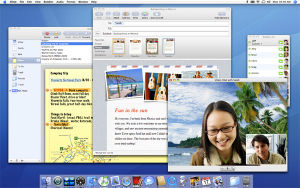Mac OS X
Mac OS X is a proprietary, Unix-based operating system developed, marketed, and sold by Apple Inc., which currently ships on all Macintosh computers. It succeeds the original Mac OS with its Aqua graphical user interface and Cocoa API, based on technologies of the dead OPENSTEP operating system from NeXT, absorbed with Apple's purchase in late 1996.[1] The operating system was first released in 1999 in the form Mac OS X Server 1.0, with a desktop-oriented version following in March 2001. Mac OS X has ever since become the most used and probably most popular Unix in the world. Its open source core, named Darwin, is based on FreeBSD and the Mach microkernel and integrates many open source software.[2] It comes with Apple's free software development suite named Xcode. Freely supplied with every Macintosh.
Platforms
Mac OS X is multi-platform, with builds in Apple products running on PowerPC processors, x86 and x86-64 processors, and at least one form of ARM processor.
History
Following the limited success of Apple attempts to modernize its Mac OS (the Copland Project), the company decided to use existing technology for the tenth version of its operating system. While Be Inc seemed to be the most appropriate candidate, NeXT's technologies were chosen as the basis for Apple's new operating system. Rhapsody, code name for the system, joined the Mach microkernel, a BSD operating system layer, the Yellow Box object-oriented frameworks from OPENSTEP and the Blue Box environment for backwards-compatibility with the classic Mac OS. Rhapsody evolved into Mac OS X Server 1.0[3], which became the predecessor to Mac OS X. Each new version of Mac OS X evolved away from a focus on backward compatibility with the earlier versions of Mac OS, with the transition to Intel processors making Apple finally discard the Classic mode, included in versions for the PowerPC.
Mac OS X has seen 5 releases as of early 2007. Mac OS 10.0 was the first release, and Mac OS 10.4 is the most recent, with a projected release of the next major iteration —Mac OS 10.5 "Leopard"— sometime in spring 2007.
Versions
| Version | Code name* | Release date | Major new features |
|---|---|---|---|
| 10.0 | Cheetah | March 24, 2001[4] | |
| 10.1 | Puma | September 25, 2001 | CD and DVD burning, DVD Player[5] |
| 10.2 | Jaguar | August 24, 2002 | iChat[6] |
| 10.3 | Panther | October 24, 2003 | Exposé, Safari[7] |
| 10.4 | Tiger | April 29, 2005 | Spotlight, Dashboard[8] |
| 10.5 | Leopard | Spring 2007 | Time Machine, ZFS, Spaces[9] |
- From version 10.2 onwards, code names were employed for branding.
References
- ↑ Singh, Amit (2004-01-07). A Brief History of Mac OS X. What is Mac OS X?.
- ↑ Singh, Amit (2004-01-07). Architecture of Mac OS X. What is Mac OS X?.
- ↑ Anguish, Scott (1998-07-09). Apple Renames Rhapsody, now Mac OS X Server.
- ↑ Mac OS X “Gold Master” Released To Manufacturing (2001-03-07).
- ↑ Apple Previews Next Version of Mac OS X (2001-07-18).
- ↑ Apple Introduces “Jaguar,” the Next Major Release of Mac OS X (2002-07-17).
- ↑ Apple Announces Mac OS X “Panther” (2003-10-24).
- ↑ Apple Unleashes “Tiger” Friday at 6:00 p.m. (2005-04-28).
- ↑ Apple Previews Mac OS X Leopard (2006-08-07).
External links
- Mac OS X - The official Apple web page for the Mac OS X operating system
- Apple Developer Connection - Resources for Mac OS X developers
